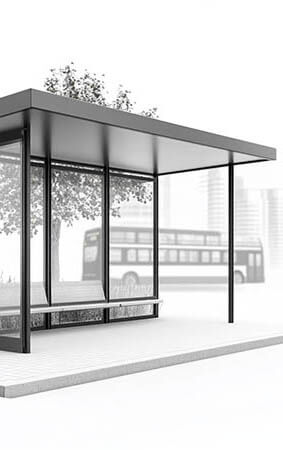The Importance of Bus Shelter Design
A well-designed bus shelter enhances the visibility and accessibility of bus stops, ensuring that passengers feel safe and comfortable while waiting for their transit vehicle. Key considerations in shelter design include:
- Location and Design: The placement of the bus shelter should be strategic, ideally set back at least 10 feet from the curb to ensure safety and minimize obstruction for pedestrians. This positioning also allows for clear visibility of bus stop signs and the shelter itself from a distance, making it easier for riders to locate their transit stop.
- Comfort and Accessibility: A comfortable shelter must accommodate the needs of all passengers, including those with disabilities. Our designs feature seating options such as benches, with ample space for wheelchair access. The interior layout must provide enough room for passengers to maneuver, ensuring that the shelter is accessible for everyone.
- Safety and Security: Incorporating adequate lighting within the shelter significantly enhances safety during evening hours. Transparent materials can also be used to ensure visibility, allowing riders to see inside and discouraging anti-social behavior.
Creative Design Elements
At SEEDiA, we embrace creative solutions in our bus shelter design. Here are some innovative elements we incorporate:
- Solar Power: Our solar bus shelters harness renewable energy to power lighting and digital displays, providing real-time information about bus arrivals. This not only improves the rider experience but also supports sustainability in urban environments.
- Integrated E-Mobility Solutions: With the rise of e-bikes and e-scooters, our bus shelters can be equipped with charging stations, making them multifunctional spaces for modern transit needs. This integration supports a seamless transition between different modes of transportation.
- Interactive Features: To cater to touch device users, we design shelters with interactive displays that allow riders to explore bus schedules and local amenities. This feature enhances engagement and provides a tech-savvy touch to the traditional bus stop experience.
Design Guidelines for Bus Shelters
When developing our bus shelter designs, we adhere to various design guidelines to ensure they meet the needs of both passengers and city planners:
- Modular Size and Dimensions: Our shelters are modular, allowing for customization in width and length to fit the specific requirements of different locations. This flexibility ensures that each shelter can be tailored to the unique space available at any bus stop, accommodating a significant number of people while allowing for adequate movement inside the shelter.
- Orientation and Layout: The entrance of the shelter should be oriented towards the street to facilitate easy access for riders approaching from the sidewalk. Additionally, bus riders should have a clear line of sight to the arriving transit vehicle to minimize confusion during boarding.
- Signage and Branding: Effective bus stop signs and advertising spaces can enhance the visibility of the shelter and provide important information to passengers. Incorporating logos and branding within the design can help transit agencies communicate their identity and engage with the community.
Conclusion: Shaping the Future of Transit
In conclusion, SEEDiA’s commitment to innovative bus shelter design is about more than just aesthetics—it’s about creating comfortable, safe, and functional transit environments that cater to the needs of all users. By incorporating solar technology and e-mobility solutions, we are shaping the future of public transit and enhancing the public space for all.
For more ideas on how we can transform bus stops and improve public transit in your city, explore our design guide or contact us today!





